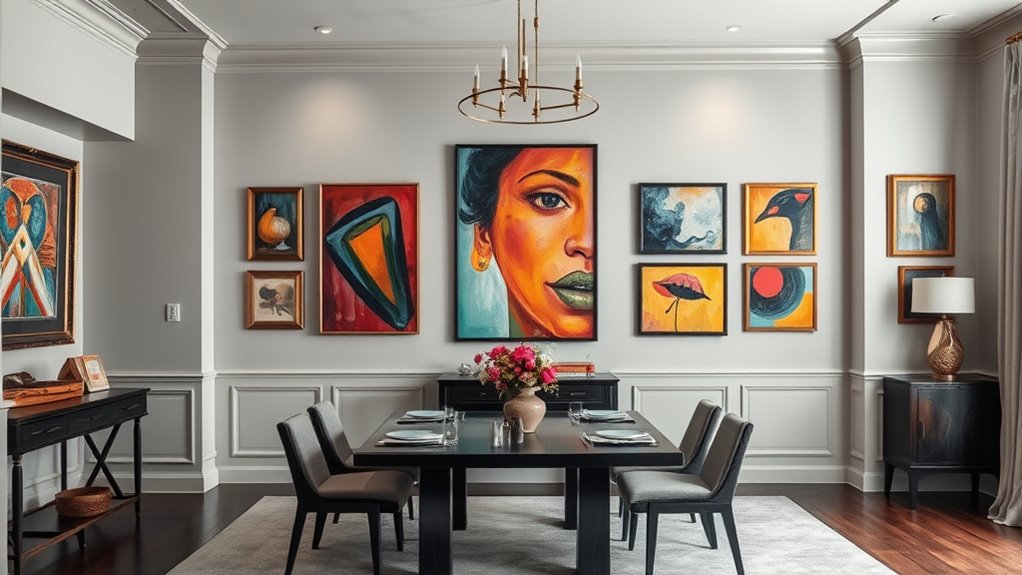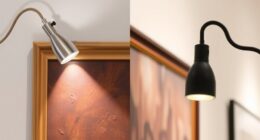To create a striking focal gallery wall in your dining room, start by choosing a cohesive theme and color scheme that reflect your personality. Select artwork and decor that complement your style, then arrange them thoughtfully for visual balance. Mix frame sizes and styles for interest, ensuring some larger pieces anchor the display. Add personal touches like photos or memorabilia for uniqueness. Keep everything fresh and polished with regular updates—more tips to help you craft a stunning gallery await.
Key Takeaways
- Select a large, eye-catching artwork or centerpiece to serve as the gallery’s focal point.
- Arrange remaining pieces around the focal point with balanced spacing and complementary frame styles.
- Choose a cohesive color scheme and mix frame sizes and styles for visual interest.
- Incorporate personal photos and memorabilia to add personality and uniqueness.
- Regularly refresh and maintain the gallery by rearranging, rotating artworks, and cleaning frames.
Choosing the Perfect Theme and Color Scheme
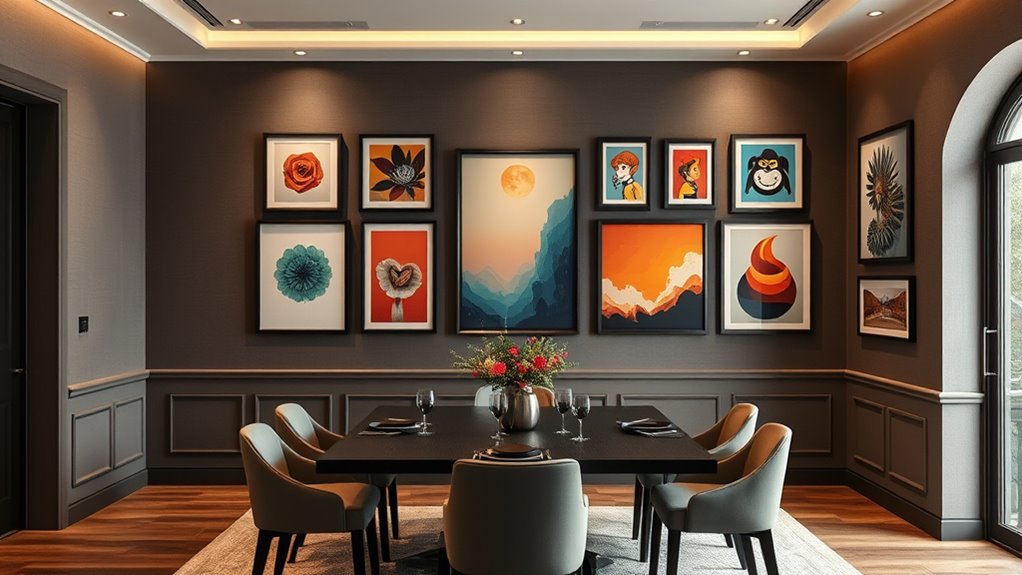
Choosing the perfect theme and color scheme for your dining room sets the foundation for a cohesive and inviting space. Your choice directly influences color harmony and mood setting, creating an atmosphere that feels warm and welcoming. Consider how different colors evoke emotions—soft neutrals promote calm, while bold hues energize the room. Think about the overall style you want; a modern look may favor sleek, neutral tones, while a rustic theme might incorporate earthy shades. Keep in mind that your color choices should complement existing furniture and decor. Selecting a harmonious palette guarantees visual balance and enhances the room’s ambiance. Additionally, paying attention to cohesive design elements can help ensure your pet remains comfortable and stylish in your home environment. Ultimately, your theme and colors should reflect your personality and make every meal feel special.
Selecting Artwork and Decorative Items
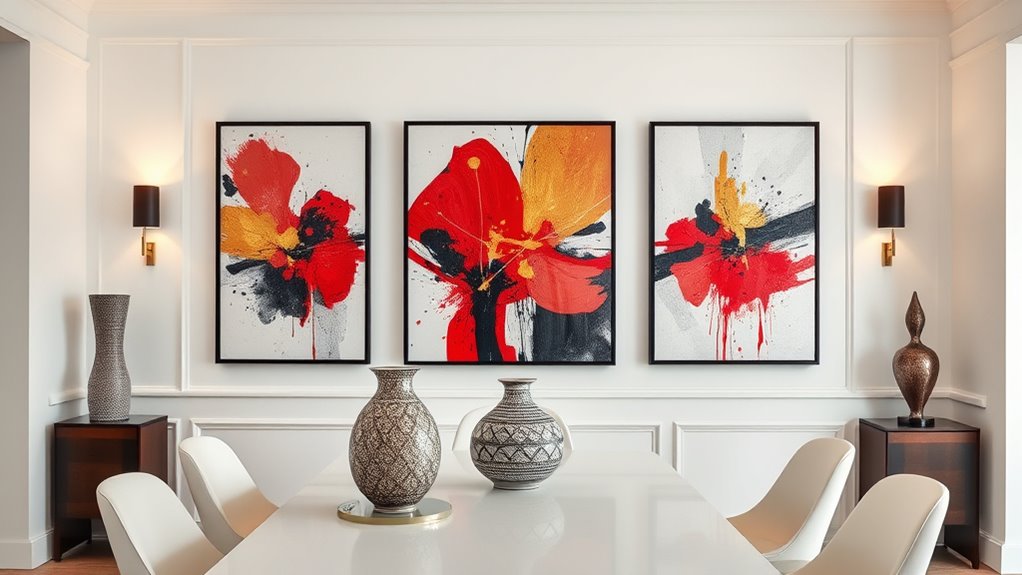
Once you’ve established your theme and color scheme, selecting artwork and decorative items becomes essential to bringing your dining room to life. Start by choosing pieces that complement your overall style—whether bold, subtle, modern, or classic. Use alternative hanging techniques like gallery rails or leaning frames to add visual interest and flexibility. When selecting decorative objects, focus on choosing items that enhance your artwork without overwhelming it. Think about incorporating complementary decorative objects such as vases, sculptures, or textiles that echo your color palette or theme. Keep balance in mind—avoid clutter and ensure each piece contributes to a cohesive focal point. Incorporate visual harmony by carefully arranging your decor to create a balanced, appealing display. Thoughtful selection and strategic placement of artwork and accessories set the tone for an inviting, personalized dining space. Additionally, considering backup power options like portable generators or solar-powered lighting can help maintain ambiance during outages or storms, ensuring your space remains welcoming and functional. Understanding the divorce process in your state can also provide inspiration for creating a warm, inviting environment that feels both stylish and comfortable.
Arranging Your Gallery for Visual Balance
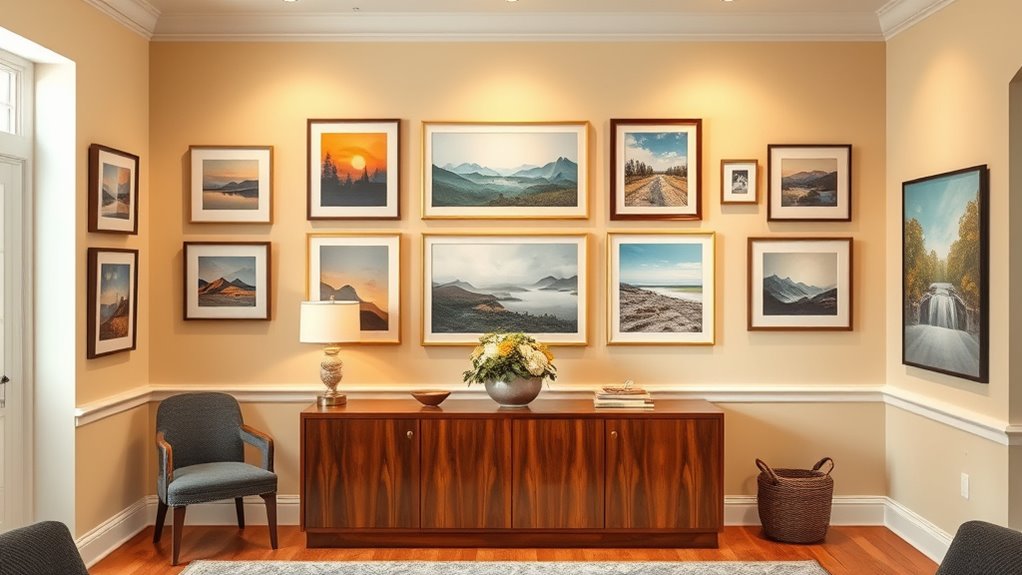
To create a harmonious gallery wall, you need to carefully arrange your artwork and decorative items so they work together as a cohesive whole. Start by establishing a focal point, such as a large piece or centerpiece, to anchor your arrangement. Next, consider symmetry and asymmetry—balance larger items with smaller ones to avoid clutter or imbalance. Use these strategies:
- Place your focal point slightly off-center for visual interest, balancing other pieces around it.
- Mix sizes and shapes, but keep the overall layout balanced to maintain harmony.
- Ensure even spacing between pieces to create a cohesive flow, whether you prefer symmetry or asymmetry.
- Sizing and load‑planning tools can help you determine the best arrangement to distribute visual weight evenly across your gallery wall. Additionally, understanding visual balance principles can enhance your overall design, especially when considering the weight distribution of each piece. Incorporating visual weight considerations can help achieve a more polished and balanced look.
Incorporating Different Frame Styles and Sizes
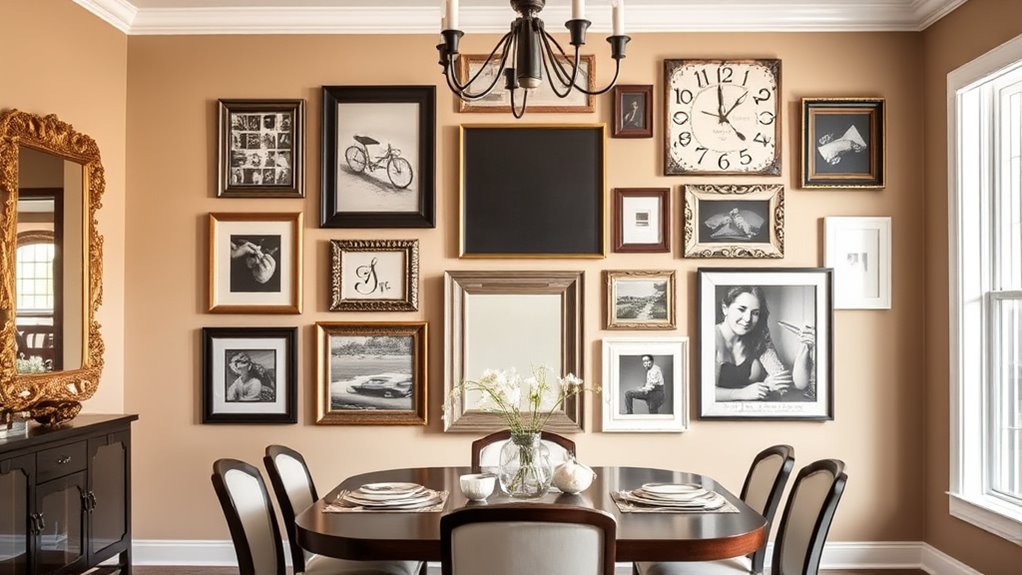
Mixing frame materials and textures can add depth and interest to your dining room walls. Varying frame sizes helps create a dynamic, eye-catching display. When combining different styles, aim for harmony to keep the arrangement balanced and cohesive. Incorporating visual balance ensures the display remains attractive and well-organized. Paying attention to color coordination can further unify the diverse frames and enhance the overall aesthetic. Additionally, considering AI-driven design tools can assist in visualizing different arrangements to achieve optimal harmony. Exploring family-inspired themes can also add personal significance and warmth to your gallery wall.
Mixing Frame Materials and Textures
By combining different frame materials and textures, you can create a dynamic and inviting dining room wall display. Mixing metals like brushed gold and matte black adds visual interest, while textured fabrics such as linen or burlap give depth. To effectively blend these elements, consider these tips:
- Use mixed metals in frames for contrast and sophistication.
- Pair textured fabrics with smooth surfaces to balance tactile variety.
- Opt for a variety of frame styles—like ornate and sleek—to enhance the eclectic feel.
This approach keeps your gallery lively and engaging, with a rich mix of materials that reflect your style. The key is to create harmony by balancing shiny and matte finishes, soft and hard textures, and diverse frame styles.
Varying Frame Sizes Arrangement
Varying frame sizes and styles can transform your dining room wall into an engaging gallery. Mix large, medium, and small frames to create visual interest and balance. Incorporate matte finishes for a sleek, modern look that reduces glare and highlights your artwork or photos. Use shadow box frames for depth, especially for items with dimension or sentimental value. Combining different frame styles—such as ornate, minimalist, or rustic—adds texture and personality. Keep in mind that varying sizes create a dynamic display, guiding the eye naturally across the wall. Arrange these frames thoughtfully, ensuring the grouping feels cohesive. This variety not only showcases your collection but also makes your dining space feel warm and inviting. Paying attention to visual balance and harmony ensures a polished and appealing gallery arrangement. Additionally, understanding merchandise presentation can help you optimize the way your artwork is displayed for maximum impact. Incorporating frame styles and sizes thoughtfully can also enhance the overall aesthetic and complement your interior decor. To further elevate your display, consider the importance of personality expression, which allows your gallery to reflect your unique style and taste.
Combining Frame Styles Harmoniously
To create a cohesive and visually appealing gallery wall, you need to combine different frame styles and sizes thoughtfully. Start by balancing matching frame borders with contrasting frame colors to add interest. Consider these tips:
- Mix frame styles—use sleek modern frames alongside ornate vintage ones for variety.
- Vary sizes intentionally, placing larger frames centrally and smaller ones around them.
- Use matching frame borders for a unified look, but introduce contrasting frame colors to highlight certain pieces.
- Remember that attention is crucial; focusing fully on your gallery arrangement will help you see how different elements harmonize. Incorporating appliance maintenance plans to ensure your walls stay pristine can also be helpful, especially if you’re using frames that require regular cleaning or upkeep. Additionally, paying close attention to detail during setup helps you achieve a balanced and polished appearance. Understanding frame styles and how they influence the overall aesthetic can further enhance your gallery wall design. This approach creates harmony while allowing individual pieces to stand out. Contrasting frame colors can bring vibrancy, while matching borders provide consistency. Combining these elements ensures your gallery wall feels curated and intentional, rather than chaotic or mismatched.
Adding Personal Touches With Photos and Memorabilia
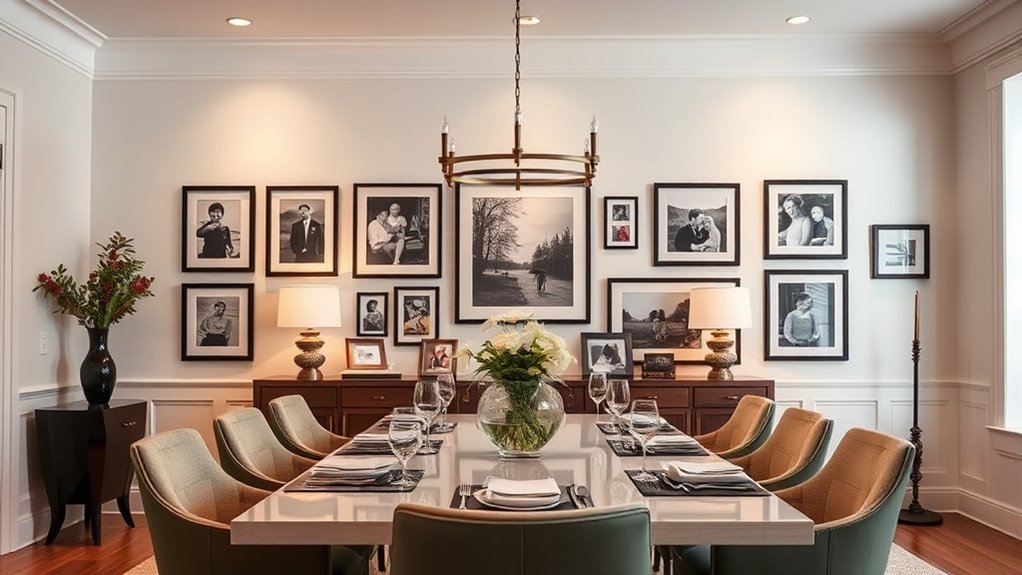
Adding personal touches with photos and memorabilia can instantly make your dining room feel warmer and more inviting. Displaying family photos in stylish frames adds a personal narrative, making the space uniquely yours. Consider creating a dedicated memorabilia display—like a vintage tray or a collection of travel souvenirs—to showcase meaningful memories. Mix different sizes and frame styles for visual interest, but keep the arrangement cohesive. Incorporate these elements thoughtfully, balancing them with your overall decor to avoid clutter. Personal touches not only add character but also spark conversations during gatherings. Remember, the goal is to create a space that reflects your story and makes you feel at home. Keep it authentic, simple, and intentional for the best effect. Fostering a creative environment at home can further enhance your space’s warmth and personality.
Maintaining and Refreshing Your Gallery Wall
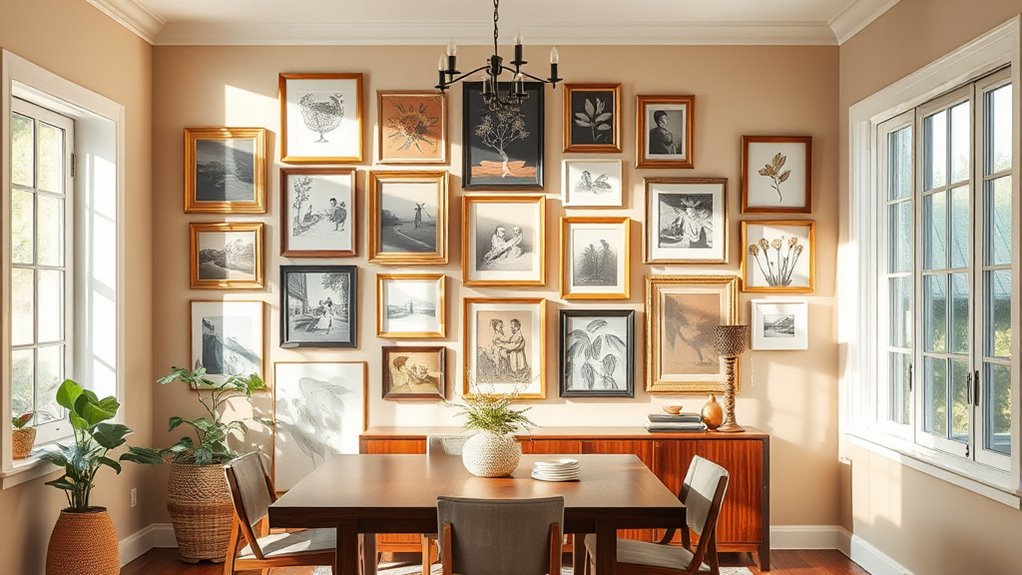
To keep your gallery wall looking fresh, try rearranging your artwork periodically to create a new focal point. Rotating in new pieces keeps the display interesting and reflects your evolving style. Make sure to clean and maintain the frames to preserve their appearance and protect your artwork over time.
Regularly Rearrange Artwork
Have you ever noticed how a gallery wall can feel fresh and inviting with just a simple rearrangement? Regularly shifting your artwork keeps the display lively and engaging. Here are three tips to refresh your gallery wall:
- Switch out pieces for a seasonal display, highlighting holiday or seasonal themes.
- Group artwork thematically, such as grouping all black-and-white photos or nature-inspired pieces.
- Rearrange existing pieces to create new visual flow, balancing size and color for a cohesive look.
Rotate New Pieces In
Revitalizing your gallery wall isn’t just about rearranging existing pieces; it’s also about introducing new artwork to keep the display dynamic. Art rotation allows you to swap out pieces periodically, giving your wall fresh interest and preventing it from feeling stale. Incorporate seasonal updates by selecting artwork that reflects current themes or colors, making your dining space feel timely and inviting. When rotating new pieces in, consider balancing different styles, sizes, and textures to maintain visual harmony. Keep a dedicated space or storage for art you’re not currently displaying, so switching pieces becomes effortless. Regularly updating your gallery with new artwork keeps your space lively and engaging, encouraging conversation and admiration from guests while showcasing your evolving taste.
Clean and Maintain Frames
Regularly cleaning and maintaining your frames is essential to keep your gallery wall looking fresh and polished. Proper frame cleaning prevents dust buildup and preserves the artwork, while adjusting gallery lighting enhances visual appeal. To refresh your frames:
- Gently dust the frames with a soft cloth or microfiber duster to remove surface dirt.
- Use a damp cloth to clean glass or acrylic covers, avoiding harsh chemicals that can damage finishes.
- Check and tighten any loose hanging hardware to ensure stability and proper alignment.
Additionally, consider adjusting gallery lighting to highlight your art and reduce glare. Regular maintenance keeps your gallery wall vibrant and inviting, ensuring your carefully curated pieces remain the focal point of your dining room.
Frequently Asked Questions
How Can I Make My Gallery Wall More Cohesive?
To make your gallery wall more cohesive, start by choosing consistent frame styles and colors that complement each other. Stick to a unified color scheme for your artwork or photos to create harmony. Arrange the pieces thoughtfully, balancing sizes and shapes. You can also use mats or borders that match your frames to unify diverse artwork. This approach helps your gallery wall look intentional and visually appealing, tying everything together seamlessly.
What Lighting Options Work Best for Gallery Walls?
You should consider LED lighting and picture lights to highlight your gallery wall. LED lights offer energy efficiency and customizable color options, creating a vibrant focal point. Picture lights add a classic touch, casting focused illumination on individual pieces. Combining both gives you dynamic control over ambiance, drawing attention to your art and making your gallery wall pop, all while complementing your decor style seamlessly.
How Do I Prevent Artwork From Damaging the Wall?
To prevent artwork from damaging your wall, use proper wall protection like adhesive options that are gentle on surfaces, such as removable hooks or damage-free strips. Avoid nails or heavy fasteners that can leave marks. Choose adhesive options designed for delicate walls, and verify they’re rated to hold your artwork’s weight. Regularly check and replace any adhesives to maintain wall integrity while displaying your gallery.
What Are Budget-Friendly Ways to Create a Gallery Wall?
You can create a budget-friendly gallery wall by mixing affordable frames with DIY wall art. For example, you might gather inexpensive frames from thrift stores and fill them with your own painted or printed designs. Arrange these on your wall in a cohesive layout. This approach saves money while giving your space a personalized, stylish focal point, showcasing your creativity without overspending.
How Often Should I Update or Rotate My Gallery Artwork?
You should update your gallery artwork every few months to keep your space fresh and engaging. Regular artwork rotation permits you to showcase new pieces and reflect your evolving style. Consider updating your gallery at least quarterly or seasonally, depending on your collection size and personal preference. This ongoing process keeps your dining room lively and ensures your focal gallery remains a dynamic centerpiece, inviting admiration from guests and family alike.
Conclusion
Your dining room walls are like a blank canvas waiting to tell your story. By choosing the right theme, artwork, and personal touches, you turn an empty space into a mesmerizing gallery that reflects your style. Keep it fresh and balanced, like a well-composed symphony. With a little creativity and care, your walls will become a stunning focal point, inviting friends and family to gather and share memorable moments amidst your personalized masterpiece.
